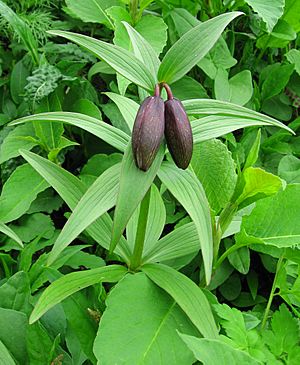Fritillaria camschatcensis facts for kids
Quick facts for kids Kamchatka lily |
|
|---|---|
 |
|
| Scientific classification | |
| Synonyms | |
|
The Fritillaria camschatcensis is a special type of plant known as a fritillary. It grows naturally in places like northeastern Asia and northwestern North America. You can find it in northern Oregon, Washington, British Columbia, and Alaska. It also grows in northern Japan and the Russian Far East. This includes areas like Amur, Kamchatka, Khabarovsk, Magadan, Primorye, Sakhalin, and the Kuril Islands.
This plant has many interesting common names. People often call it the Kamchatka fritillary or Kamchatka lily. It's also known as the rice lily or northern rice-root. This is because of the small, rice-like bulbs that grow around its roots.
Sometimes, it's called the skunk lily, dirty diaper, or outhouse lily. These names come from the flower's rather unpleasant smell. Another common name is chocolate lily because of its dark brown color. However, be careful! That name is also used for other plants like Fritillaria biflora or Arthropodium strictum, which actually smell like chocolate.
What the Kamchatka Lily Looks Like
The Kamchatka lily grows from special underground parts called bulbs. These bulbs are made of several large, fleshy scales. They look a bit like the cloves you find in a garlic bulb.
The plant's leaves are long and narrow, growing up to 10 centimeters (about 4 inches) long. They are arranged in circles around the stem. The stem itself can grow quite tall, reaching up to 60 centimeters (about 2 feet) high.
At the very top of the stem, you'll find the flowers. These flowers can spread out or hang downwards. They are usually a dark brown color, but sometimes they have yellow spots or patterns.
How People Use the Kamchatka Lily
The Kamchatka lily produces starchy bulbs. These bulbs are a food source for many different wild animals. They have also been an important food for the Native peoples living in the regions where the plant grows.
In 2012, there was a small effort in British Columbia to bring back the use of this plant. First Nations communities on the West Coast wanted to use it more often as a traditional food.
See also
 In Spanish: Fritillaria camschatcensis para niños
In Spanish: Fritillaria camschatcensis para niños

